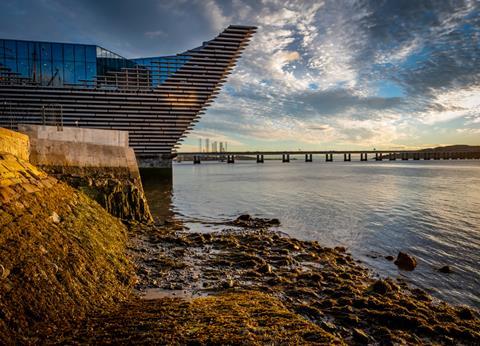With its strongly devolved government and separate regulatory regime, Scotland is often neglected in conversations about the UKŌĆÖs built environment. Daniel Gayne took a trip north of the border to see what is going on


ŌĆ£Scotland is a village,ŌĆØ says Alastair Wallace to a dinner table full of colleagues, clients and friends ŌĆō ŌĆ£everyone knows everyoneŌĆØ.
As if to demonstrate the point, Wallace, a senior partner at locally based consultant Thomas and Adamson (T&A), has collected a whoŌĆÖs who of Scottish construction in a room at the Edinburgh Grand to give ║├╔½Ž╚╔·TV the lay of the land north of the border.
His testament to the countryŌĆÖs unique smallness seems at first to be an unusual claim ŌĆō after all, if Scotland is a village, it is one with more than ┬Ż160bn GDP ŌĆō but itŌĆÖs not the first or last time this reporter hears the comment made during his three-day trip in the country.
This smallness has a paradoxical quality. It appears to be a source of both the pride and frustration demonstrated by those around the table.
On the one hand, there is a belief within the market that practices are more honest and collaborative than down south. ŌĆ£My god, we are not scared to fall out, but at the same time you are only three months away from meeting each other on the next job, so actually we all get on really well,ŌĆØ says Wallace. ŌĆ£So, the team ethos is really strong on jobsŌĆØ.
ŌĆ£The great thing about the Scottish industry is you can always pick up the phone to an MD and, as a client, you can always say if you have got an issue,ŌĆØ adds Karen Pickering, estate development manager at the University of Edinburgh. ŌĆ£IŌĆÖve worked down in England and you cannot do that.ŌĆØ
This sense of purpose and enthusiasm was evident on a visit to the KingŌĆÖs Theatre, which is currently undergoing major modernisation work. The venue is a beloved city institution and those working on the job were keen to share with ║├╔½Ž╚╔·TV their personal memories of their first visit to the panto and how much the project meant to them.
EdinburghŌĆÖs KingŌĆÖs Theatre

EdinburghŌĆÖs KingŌĆÖs Theatre is so beloved by residents that it is widely known as the PeopleŌĆÖs Theatre. It welcomes 200,000 visitors a year and is most famous for its annual pantomime.
But it was no longer fit for purpose as a 21st century venue and had been at risk of closure until Capital Theatres raised ┬Ż7.2m ŌĆō mostly from the city and Scottish government ŌĆō to fill a funding gap that emerged last year due to inflation.
The cash has allowed contractor Robertson Group to re-start work to revamp the theatre, raising the flytower and flattening the raked stage to enable more touring acts to perform at the venue, and installing new lifts at the front and back of house to make it fully accessible for the first time.
KingŌĆÖs Theatre will also be made open to the public outside of performance house, with a new on-street caf├®, bar spaces and a creative engagement suite.
Project team | Project Manager: Thomas and Adamson | Architect: Bennetts Associates | Structural Engineer: Will Rudd Davidson | Services Engineer: Max Fordham | Quantity Surveyor: Gleeds
But the flipside of this is a perception of Scotland as a parochial market with high build costs and a high-risk profile. Paul Curran, chief executive of Qmile Group, the developer responsible for the redevelopment of the Quartermile neighbourhood and the forthcoming Haymarket development, describes how these qualities have seen the UKŌĆÖs largest contractors drift away.
ŌĆ£If you are talking about the tier one contractors, there sort of arenŌĆÖt any in Scotland anymore,ŌĆØ he says. ŌĆ£Your McAlpines are effectively pulling out, Balfour Beatty only do infrastructure and university stuff, so you donŌĆÖt really have that depth of market [ŌĆ”] we used to have a list about 12 main contractors who could cope with scale, now you are very limited with who you can go to site withŌĆØ. He adds that more firms moving to a sector-focused rather than regional structure meant Scotland losing a dedicated presence and that the transience of subcontractorsŌĆÖ labour markets were another challenge, with a sense among workers that ŌĆ£LondonŌĆÖs streets are paved with goldŌĆØ.
Glasgow-based Heather Holbrook, T&AŌĆÖs newest partner, agrees such supply chain issues are common, with challenges accessing skilled trades like joinery and specialist contractors. ŌĆ£A big concrete frame of scale, you are kind of limited with contractors that can do a job of that scale in Scotland because a lot have withdrawn,ŌĆØ she says. ŌĆ£We used to have Keltbray but they withdrew. You are kind of limited to Cidon and Careys.ŌĆØ
I think the skillset in Scotland is significantly higher in every area of the property industry than elsewhere
Alastair Wallace, senior partner, Thomas & Adamson
Wallace contends that the relative coolness of the market in comparison to London provides some benefits, though, making a bold claim about the comparative quality of services in Scotland and the UK capital. ŌĆ£As someone who sees the UK and arguably oversees as well, I think the skillset in Scotland is significantly higher in every area of the property industry than elsewhere,ŌĆØ he says. ŌĆ£You have got to earn your crust [in Scotland]ŌĆØ.
ŌĆ£I personally hear that from clients south of the border who are doing business up here,ŌĆØ says Chris Cuthbert, director of boutique property consultancy CuthbertWhite. Perhaps part of the reason is the higher standards built environment professionals are held to in Scotland, with a building warrant system separate from planning approval meaning developers have to demonstrate exactly how projects will be built before getting the green light.

ScotlandŌĆÖs rather more interventionist approach to regulation does not receive universal acclaim, however. The SNP government introduced a rent freeze in September 2022 and subsequently established a temporary rent cap limiting annual rises to 3% ŌĆō a move the industry says has stifled build-to-rent development. Ian Gracie, construction director at Drum Property Group, says he thinks rent controls are a good thing but that they were introduced undemocratically and counter-productively, spooking investors. He says: ŌĆ£Proper rent control with a rent review period built into legislation? No problem, because funders can allow for it, developers can allow for it, and the market knows what to expectŌĆØ.
The fear of major, sudden and unexpected has long been cause for fundersŌĆÖ coolness on the Scottish property market, which brings us to the elephant in the room ŌĆō independence. The Buccleuch Group is synonymous with Scottishness, named for the Duke of Buccleuch, one of the countryŌĆÖs biggest private landowners. But in advance of the referendum in 2014, the business ŌĆ£took a deliberate stance to reduce our exposure to the Scottish marketŌĆØ, according to managing director David Peck. Between 20% and 25% of its business is Scottish now, he says, compared with closer to 50% previously.
There are loads of good things here, loads of opportunity
Barry McKeane, director, Wallace Whittle
Peck contends that what he calls ŌĆ£the Holyrood issueŌĆØ remains a block on investment for Scotland. ŌĆ£I think we still have an issue of very parochial politics up here that seem to be subject to sudden change and that is a big turnoff for a lot of investors and until we see some change on that front, I think you will see Scotland suffer relative to south of the border,ŌĆØ he says.
ItŌĆÖs not all doom and gloom, though, says Barry McKeane, director at building services firm Wallace Whittle. ŌĆ£There are loads of good things here, loads of opportunity,ŌĆØ he says. ŌĆ£From a Scottish perspective, we need more investment, we need more people to come to Scotland, to see it as a stable economy, a stable marketplace where people want to invest.ŌĆØ
Case study: Glasgow Met Tower

Opened in 1964, the Met Tower is one of the most iconic structures in the centre of Glasgow. For much of its life it was home to the Glasgow College of ║├╔½Ž╚╔·TV and Printing, and while it has sat empty for almost a decade, it has remained a point of pride for Glaswegians for the slogan it bears ŌĆō People Make Glasgow.
There had been plans to turn the category B listed tower into a hotel, but after being purchased by Bruntwood SciTech in 2022, plans were put forward to transform it into a life science hub. 110,000 sq ft of space will be delivered across the 14 storeys of the tower itself, while an adjacent podium building has been demolished and will be replaced by a new 94,000 sq ft, 10-storey office building.
Corbusier-influenced roof furniture, including a barrel-vaulted gymansium designed to reference the cityŌĆÖs shipbuilding heritage, will be transformed into a 60-person lounge and double height event space with views as far as Ben Lomond.
The ┬Ż60m investment aims to turn the empty building into a commercial hub with tech and digital university spinouts, startups, scale-ups and high-profile tech businesses and will sit at the heart of Glasgow City Innovation District.
Project team | Project Manager: Ryden | Architect: Cooper Cromar | Fa├¦ade Consultant: Arup | M&E/Fire Conultant: Atelier Ten | Civil and Structural Engineer: Woolgar Hunter | Quantity Surveyor: Thomas & Adamson
One success story is the booming energy infrastructure sector, with firms taking advantage of ScotlandŌĆÖs fierce elements. Tidal power and hydroelectric are prominent, while wind has benefitted from onshore generation falling out of favour in England. Life sciences and technology are other promising areas. CBRE identified Glasgow as the UKŌĆÖs third top ŌĆśtech cityŌĆÖ outside of London, while life science firms headquartered in Scotland at large raised more than ┬Ż600m of funding between 2017 and 2020.
The growth of the sector has led to biotech-focused projects such as Bruntwood SciTechŌĆÖs proposed renovation of the iconic Met Tower, which is turning a derelict former university building into a new life sciences hub. This development raises the prospect of a pivot in GlasgowŌĆÖs office market, which has historically been tilted towards the public sector, reflecting the cityŌĆÖs enormous council staffing ŌĆō Glasgow had roughly 28,000 staff as of March 2022, significantly more than Birmingham, the UKŌĆÖs biggest local authority by area.
According to some, the dominance of a local authority reluctant to force its staff back to work has had a negative impact on the city centre, and it is hoped that a greater presence of private firms ŌĆō alongside pioneering efforts to bring residential units back into the middle of town ŌĆō could help turn the tide.
Read more: The Golden Z: GlasgowŌĆÖs radical plan to give the high street back to the people
By contrast, in Edinburgh, space in the centre of the city to develop office space of any kind is hard to come by. The Old and New Towns, which comprise a large chunk of the city centre are both UNESCO World Heritage sites, which, combined with a planning preference against tall building, makes opportunities for major new development relatively rare. M&G Real Estate and QmileŌĆÖs ┬Ż350m Haymarket development is an exception, but in another way a demonstration of these challenges. The scheme, part-complete, is squeezing three Grade A office buildings (totalling 380,000 sq ft) and a 362-room onto a tight plot next to the rail station of the same name. These constraints on supply and the booming tech sector mean the cityŌĆÖs vacancy rate is down to just over eight per cent for all grades and below one per cent for Grade A office space.
Growth on the edges of the city could help alleviate some of these issues and T&A is currently project managing the construction of ScotlandŌĆÖs biggest new housing development at Shawfair. Roughly 4,000 new homes will be built over 710ha of land previously used by Monktonhall colliery, linking up a handful of existing coal villages with EdinburghŌĆÖs suburbs.
Some things are just the same as down south, though. If death and taxes are the only certainties in life, grumbles about the planning system might be the only certainty in a conversation about the built environment. There is a particular concern about a perceived unwillingness to approve student accommodation schemes ŌĆō according to Gracie, there is currently 12,000-bed shortage for students in Glasgow.
There is an agreement among industry figures assembled that city leaders in Glasgow and Edinburgh need to be bolder and develop forward-looking visions that industry and the public can get behind. Craig Wallace, a planning specialist and partner at Montagu Evans, suggested the pair could learn a thing or two from their little sibling on the east coast, Dundee.

The city is part way through a thirty-year, ┬Ż1.6bn transformation project that will see 240ha of land along the River Tay redeveloped and has already brought a major cultural institution ŌĆō the V&A ŌĆō to its waterfront.
ŌĆ£It is building that confidence between officials and elected members which Dundee did well,ŌĆØ Wallace says. ŌĆ£Edinburgh doesnŌĆÖt do well at all and you have got the chief planner not knowing which way his committee is going to go from one week to the next. It is probably similar in Glasgow, so you need that kind of civic leadership on the right level. It can be done but its failed drastically in recent years.ŌĆØ
The hope is that good policymaking is contagious and moves to regenerate town centres suggest a sea change could be underway. T&A partner Chris Narrowmore says the role Aberdeen Council took in the recent redevelopment of its historic headquarters. A ┬Ż107m scheme, brought forward by Muse and Aviva, saw the delviery of 175,000 sq ft of office space, 5,000 sq ft of restaurant space, more than 18,000 sq ft of retail and leisure space and a roughly 150-bedroom hotel.
Crucailly, though, the council took a head lease over the entire development, giving it a share of the rent and ownership of the development over 35 years, but also responsiblity for the risk if spaces did not let. ŌĆ£They put their money where their mouth was,ŌĆØ he says. ŌĆ£There is no other way that kind of quality of scheme could have been delivered without that kind of engagementŌĆØ.
Only time will tell whether such approaches will bear fruit. What is certain is that the coming years will be interesting ones up north. The unravelling of the SNP after more than a decade in power has put Scotland back on the political chess board, with the Labour Party fixing the country at the centre of its green energy plans. Scotland might be a village, but its significance is not to be underestimated.
The ║├╔½Ž╚╔·TV the Future Commission

The ║├╔½Ž╚╔·TV the Future Commission is a year-long project, launched to mark ║├╔½Ž╚╔·TVŌĆÖs 180th anniversary, to assess potential solutions and radical new ways of thinking to improve the built environment, with thanks to our national headline sponsors Fenwick Elliott and Gleeds.
The major projectŌĆÖs work will be guided by a panel of 19 major figures who have signed up to help guide the commissionŌĆÖs work culminatuing culminate in a report published at the end of the year.
The commissioners include figures from the world of contracting, housing development, architecture, policy-making, skills, design, placemaking, infrastructure, consultancy and legal.
They include Katy Dowding, executive vice president at Skanska, Richard Steer, chair of Gleeds, Lara Oyedele, president of the Chartered Institute of Housing, Mark Wild, former boss of Crossrail and chief executive of SGN, and Simon Tolson, senior partner at Fenwick Elliott. See the full list here.
The project is looking at proposals for change in eight areas:
- Education and skills
- Housing and planning
- Energy and net zero
- Infrastructure
- ║├╔½Ž╚╔·TV safety
- Project delivery and digital
- Workplace culture and leadership
- Creating communities
>> EditorŌĆÖs view: And now for something completely positive ŌĆō our ║├╔½Ž╚╔·TV the Future Commission
>> Click here for more about the project and the commissioners
║├╔½Ž╚╔·TV the Future is also undertaking a countrywide tour of roundtable discussions with experts around the regions as part of a consultation programme in partnership with the regional arms of industry body Constructing Excellence. There is also a young personŌĆÖs advisory panel.



























No comments yet